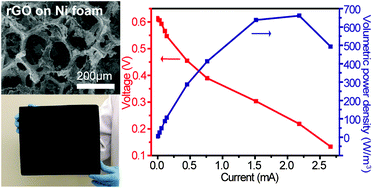High power density microbial fuel cell with flexible 3D graphene–nickel foam as anode†
Abstract
The structure and electrical conductivity of anode play a significant role in the power generation of microbial fuel cells (MFCs). In this study, we developed a three-dimensional (3D) reduced graphene oxide–nickel (denoted as rGO–Ni) foam as an anode for MFC through controlled deposition of rGO sheets onto the nickel foam substrate. The loading amount of rGO sheets and electrode surface area can be controlled by the number of rGO loading cycles. 3D rGO–Ni foam anode provides not only a large accessible surface area for microbial colonization and electron mediators, but also a uniform macro-porous scaffold for effective mass diffusion of the culture medium. Significantly, at a steady state of the power generation, the MFC device with flexible rGO–Ni electrodes produced an optimal volumetric power density of 661 W m−3 calculated based on the volume of anode material, or 27 W m−3 based on the volume of the anode chamber. These values are substantially higher than that of plain nickel foam, and other conventional carbon based electrodes (e.g., carbon cloth, carbon felt, and carbon paper) measured in the same conditions. To our knowledge, this is the highest volumetric power density reported for mL-scale MFC device with a pure strain of Shewanella oneidensis MR-1. We also demonstrated that the MFC device can be operated effectively in a batch-mode at least for a week. These new 3D rGO–Ni electrodes show great promise for improving the power generation of MFC devices.


 Please wait while we load your content...
Please wait while we load your content...